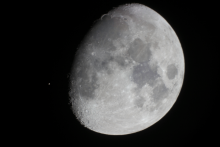Listen to today's episode of StarDate on the web the same day it airs in high-quality streaming audio without any extra ads or announcements. Choose a $8 one-month pass, or listen every day for a year for just $30.
You are here
Moon and Aldebaran
It’s easy to see that the Moon moves across the sky. Compare its position to the background of stars from one night to the next, and that motion is obvious. Tonight, for example, the bright star Aldebaran rises to the lower right of the Moon. By tomorrow night, though, the Moon will have moved so much that Aldebaran will rise farther to its upper right.
The background stars are sometimes described as “fixed” because they don’t move from night to night — or at least not enough to notice. The stars are all in constant motion as they orbit the center of the galaxy, just as the Sun does. But the stars are so far away that the change from night to night — or even century to century — is imperceptible.
Aldebaran was the first to reveal that motion. In 1718, astronomer Edmond Halley studied records of Aldebaran’s position from more than 2,000 years earlier. He found that the star had moved — by about a quarter of the diameter of the Moon in our sky. Halley then studied the motions of two more stars, which confirmed the effect.
That shift is called proper motion. Aldebaran shows a large motion because it’s close — just 65 light-years away. So the relative motions of Aldebaran and the Sun combine to produce a large shift in the star’s position.
Today, Aldebaran marks the eye of Taurus. But thousands of years from now, the star will have moved away from that spot — depriving the bull of his bright orange eye.
Script by Damond Benningfield



